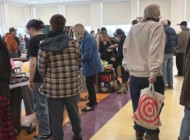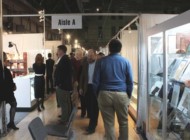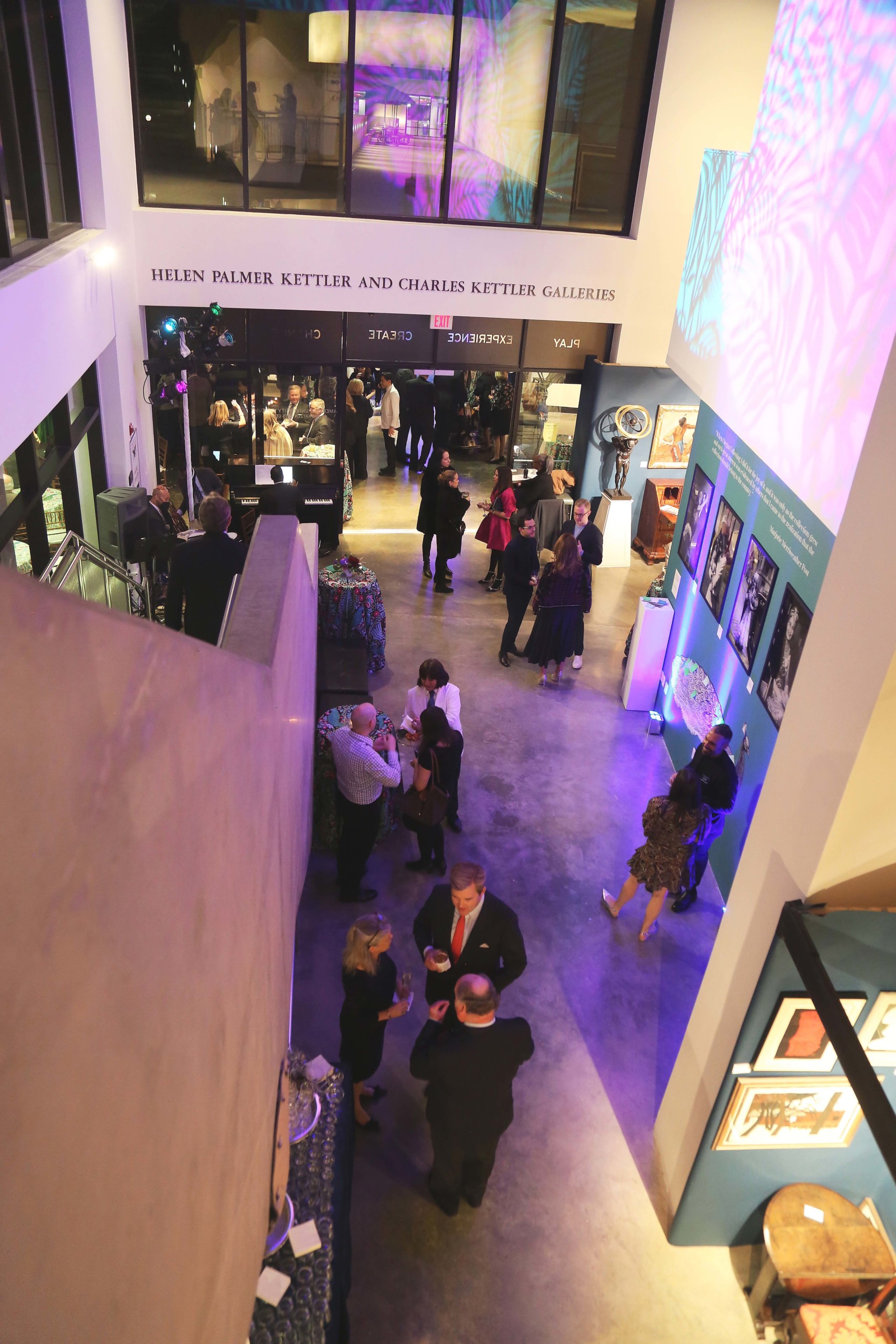
A bird’s-eye view from the second level down into the show’s main lobby and entrance.
Review & Onsite Photos by Madelia Hickman Ring
WASHINGTON DC — True to form, the 2024 Washington DC social scene got underway in a joyous way with a glitzy preview party on Thursday, January 11. It kicked off the annual three-day Washington Winter Show that ran January 12-14. Returning to The Katzen Arts Center on the campus of American University, the show fielded 41 new and returning exhibitors. The show’s theme was “For The Joy Of It” and it featured a loan exhibition from Hillwood Estate, Museum & Gardens, the Washington DC home of businesswoman, socialite, philanthropist and collector, Marjorie Merriweather Post. All those exhibitors Antiques and The Arts Weekly spoke to, both at the show and afterwards, noted the theme captured the essence and experience of the event, for both sellers and buyers.
“All the things the show committee does to get people to come always really stands out to me,” noted show manager Karen DiSaia. “All of their events — a design panel and lectures — were sold out. We had 400 people attend Jazz Night on Saturday, and the kids who attended our “Sundaes on Sunday” event really responded to the topic of decoding silver hallmarks. The show has a Young Collector’s Circle that’s quite expansive and exciting.”
Though the number of new exhibitors was less than those who came on board the previous year, there was a noteworthy reason why many long-time dealers did not participate. When the Antiques & Garden Show of Nashville — which traditionally takes place the first weekend in February at the Music City Center — moved its dates to the same weekend as the DC event, many dealers who usually do both shows had to choose which one to participate in. Three exhibitors — Thistlethwaite Americana, Earle D. Vandekar of Knightsbridge and first-time vendor Justin Westbrook — were able to field booths at both events.
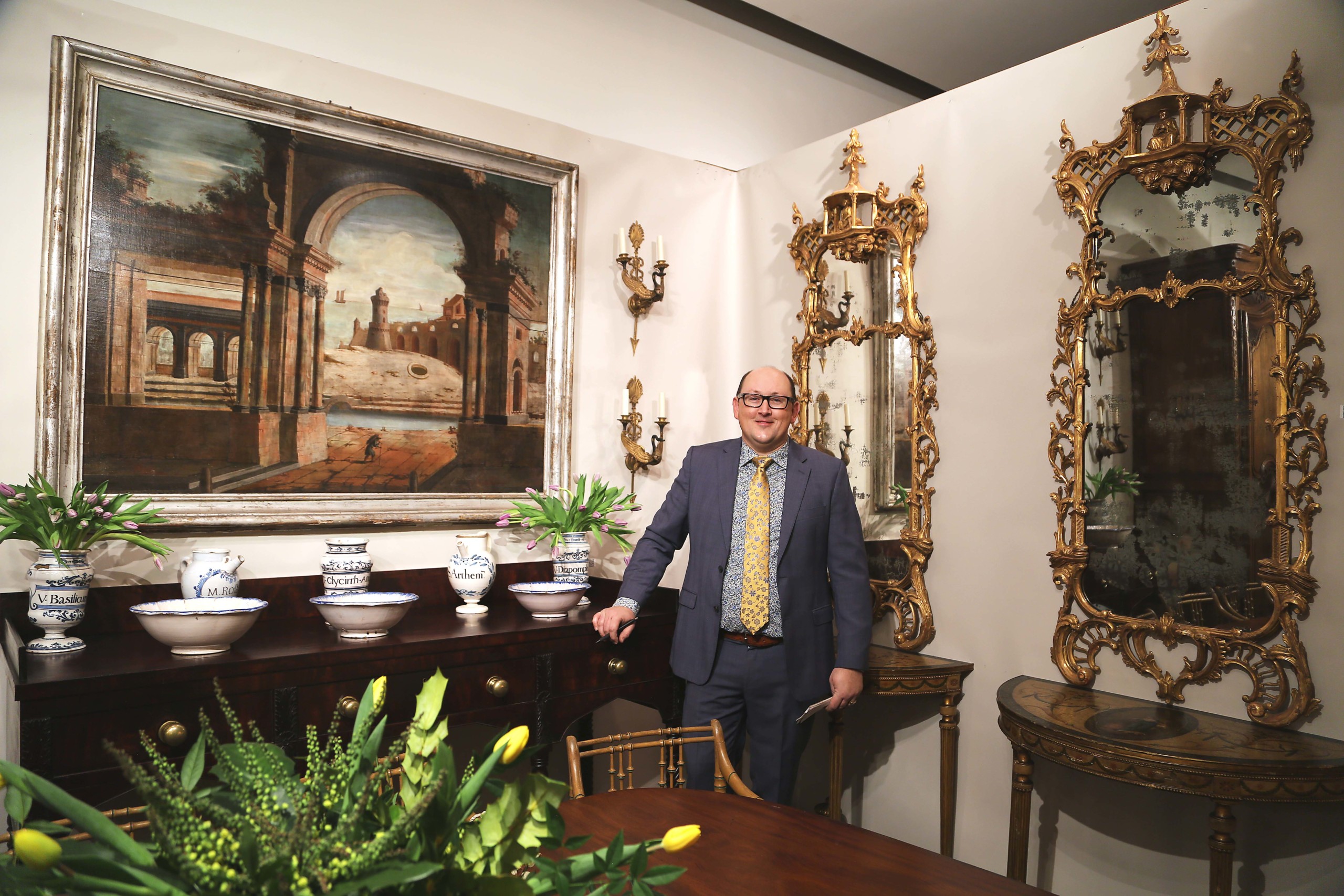
First-time vendor Justin Westbrook, shown with a large Italian landscape capriccio he’d found outside of Philadelphia, Delft pottery, a Norfolk, Va., sideboard that dated to circa 1815 and a pair of Eighteenth Century Georgian Chinese Chippendale mirrors that had provenance to Florian Papp. Richmond, Va.
Thistlethwaite took a few moments after the show to fill us in on how it was. “It was hard being at two shows at once but my brother, Clay, did very well in Nashville and I had a good show in DC. To me, it marks a real transition: the more shows I do, the more I see us move away from traditional shows and toward more design-based shows. The things I sold were prints, paintings and modern furniture and I noticed a lack of interest in traditional antiques. I sold to a lot of new clients who were young, which is a good thing. The show always has a homelike feel to me, and I saw a lot of old friends.”
He brought two works by important African American artists to the show: “Fishing on the Rocks, Shenandoah Valley, Virginia,” by Robert S. Duncanson, and “Landscape” by Edward M. Bannister. The expert on Duncanson — Michael Meyer — had helped him out with the paintings and was at the show to tell their stories. Thistlethwaite said the paintings received a lot of interest, including from some museum curators who attended the show.
“We sold across the board,” reported Vandekar’s Deirdre Healy. “Among our sales in DC were a set of engravings, sailors woolwork pictures, English pottery and Chinese export porcelain. I didn’t really see any trends in terms of buying, but the show was well attended and very busy.”
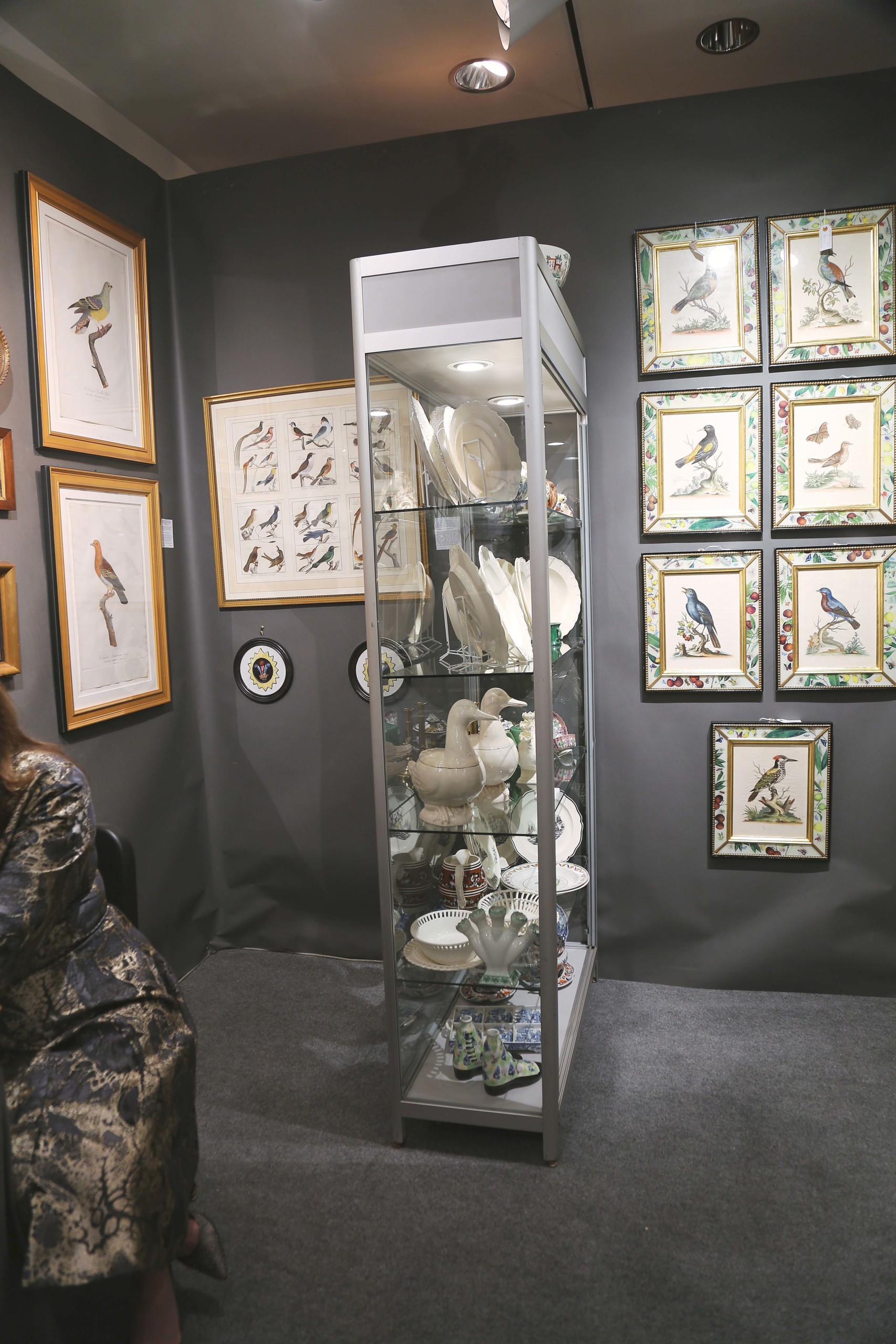
“Birds of a feather flocked together” in the second-floor booth of Earle D. Vandekar of Knightsbridge, Downingtown, Penn.
She also commented on doing two shows in different cities simultaneously. “Splitting is difficult; it is tricky selecting merchandise for two shows and trying to get a mix of great material in two shows at the same time. The workload is also heavier, setting up and taking down a show is a lot of work together, it is pretty grueling on one’s own. Ironically, my brother, Sean Healy, came to help me in Washington and Paul’s brother Nick helped him at the Nashville show, so we were both lucky to have had great help. Fortunately, we did good business at both shows, so it worked out for us, but we are not looking to repeat that again…”
“The show was good,” noted newcomer Justin Westbrook. “I’m still relatively new to Virginia — we moved to Richmond right before Covid — and this was my first real opportunity to introduce myself and businesses to folks who are close enough to come visit the shop and warehouse. Mission accomplished! I made a few sales and reconnected with a few old friends and clients that I had not seen since leaving Charleston so that was wonderful as well. Nashville was Nashville…it’s always one my best shows. They have an energy and vibe there that’s tough to duplicate and I’m always grateful to be a part of that show! I am very fortunate to have a competent and knowledgeable staff that were able to run that show with no problems while I focused on the DC show.”
Christopher Evans has been trying to get into the DC show for a few years so was thrilled space opened up for him. The Waynesboro, Va., dealer told Antiques and The Arts Weekly that his material was extremely well-received and he sold 17 or 18 things to mostly new clients, across the board in terms of price point and category. “I spoke to a young couple who came to the preview party; they came back on Friday and took photos of five things, then on Saturday came back again and bought four of the five things…that doesn’t happen at most of the Americana shows we do!”
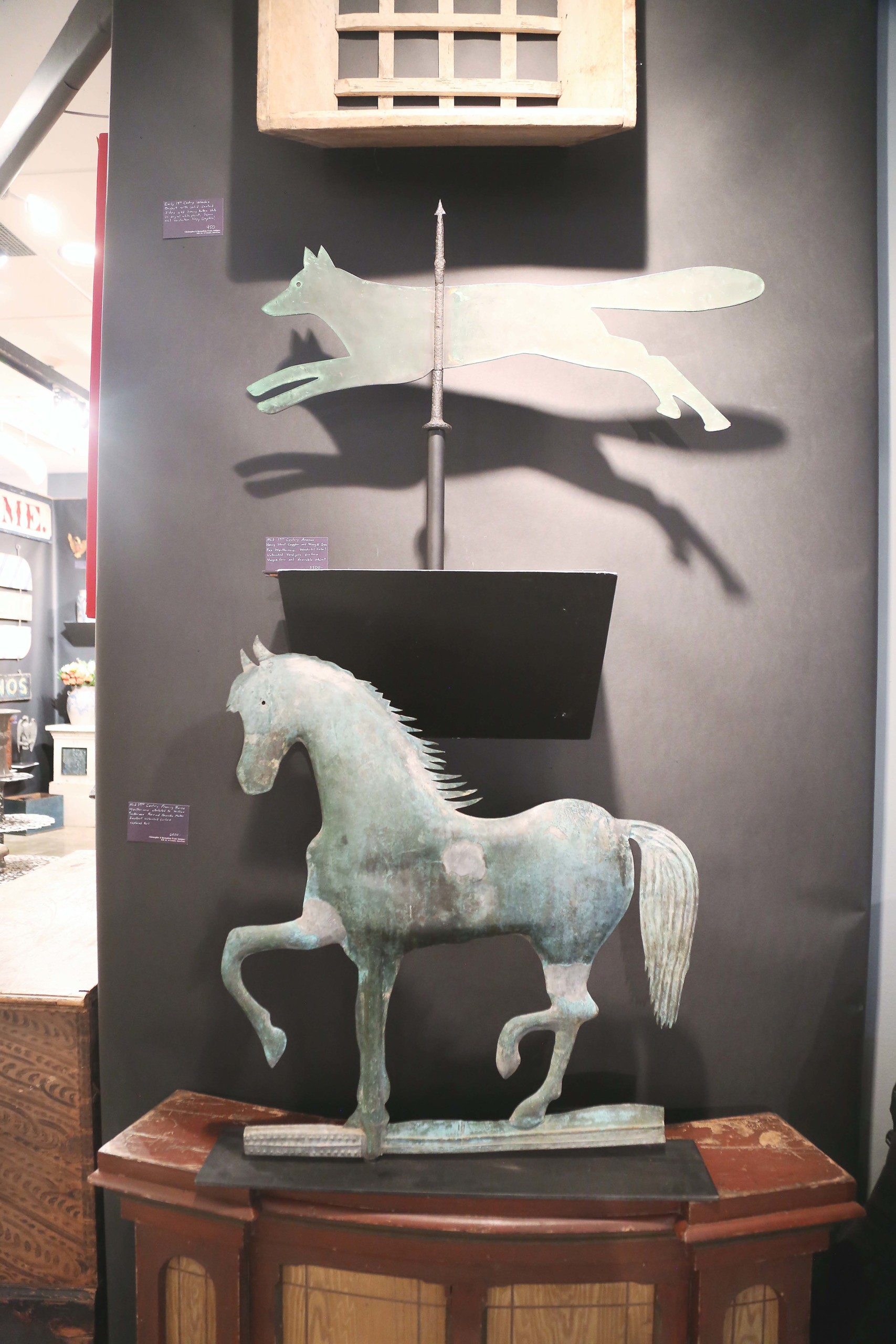
The outer wall of first-time exhibitor Christopher & Bernadette Evans was the best place to show off a sheet copper and wrought iron fox weathervane and a prancing horse weathervane attributed to William Tuckerman, both mid-Nineteenth Century. Both were still available for sale after the show. Waynesboro, Va.
Georgetown, DC, dealer Frank Milwee was also exhibiting for the first time, on the show’s third level. “The show offered the opportunity for me to see many people who had been my customer in Georgetown for years, but the high point was a short program to spend a few minutes with two separate groups of kids. I’ve always thought it particularly important to give encouragement to young people when they visit. Letting them hold things and talking to them about it ; and letting them feel free to be “grown-up” deciding what they would pick up to examine — these are things that encouraged me as a child to like old things. But the best part of all was I encountered a few of them afterwards, and the boys reached out their hand to shake mine, and say ‘thank you.’ How great is that!”
Dealers on the show’s first floor were mobbed from the time the doors opened. Thistlethwaite’s neighbors across the aisle were Ron and Joyce Bassin of A Bird in Hand Antiques. The Bassins sold a Grenfell soapstone codfish right away on opening night and over the course of the weekend tallied 27 sales, most ranging in price from $3,000 to $5,000.
“I take my hat off to the show committee; they worked very hard, and they did a great job bringing the right people in,” confirmed Ron Bassin. “Attendance was so constant we didn’t have time to do anything else and haven’t had a show like that in a long time; it was incredible. We had a lot of new customers who bought really good things, as did some of our usual customers, too. One of my favorite sales was a miniature Crowell bird to a woman who bought it for her 15-year-old son to start his collection.”
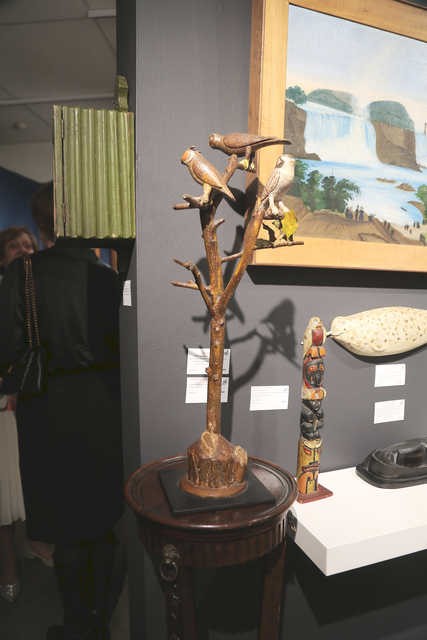
During the preview party, Ron Bassin gave a talk and featured this owl bird tree, which was dated to 1950-60 and stood 23¼ inches tall. It sold during the show. A Bird in Hand Antiques, Florham Park, N.J.
Fine art dealer Kevin Rita usually shows alongside Bruce Emond and Village Braider but with Bruce in Nashville, Garvey jockeyed into a pole position across the aisle from the Bassins. He made several sales throughout the weekend, including a classic winter landscape by Walter Emerson Baum to an Alexandria, Va., buyer, Gene Davis’ “Homage to Barnett Newman” that will adorn a wall in Georgetown, and Hermann Dudley Murphy’s “Sea and Sky,” which resonated most with a Bethesda, Md., collector.
Sandy Jacobs noted the show got the new year off to a “great start; it was very good for me this year. I had interest across the board but most of what I sold this year were jewelry and smalls. It was well attended by very interested people. I love that show, it’s always beautiful and so diverse and deep in what’s there. My best sale took place as the show was closing on Sunday: I sold three pieces of jewelry to a woman who came on Saturday and came back with a friend on Sunday.”
Jacobs’ neighbor, David Brooker, also said he had a great show, “selling to old and new clients.”
A last-minute cancellation provided an opportunity for Paris, Ky., Americana dealer Blandon Cherry, who brought a nice variety of things. He sold a few things, including a chest of drawers, reporting having “some really good quality conversations with learned buyers but no immediate sales from them. I thought Karen and her team did a fantastic job; the show looked great.” He looks forward to returning to the show with a better sense of what buyers are on the hunt for.
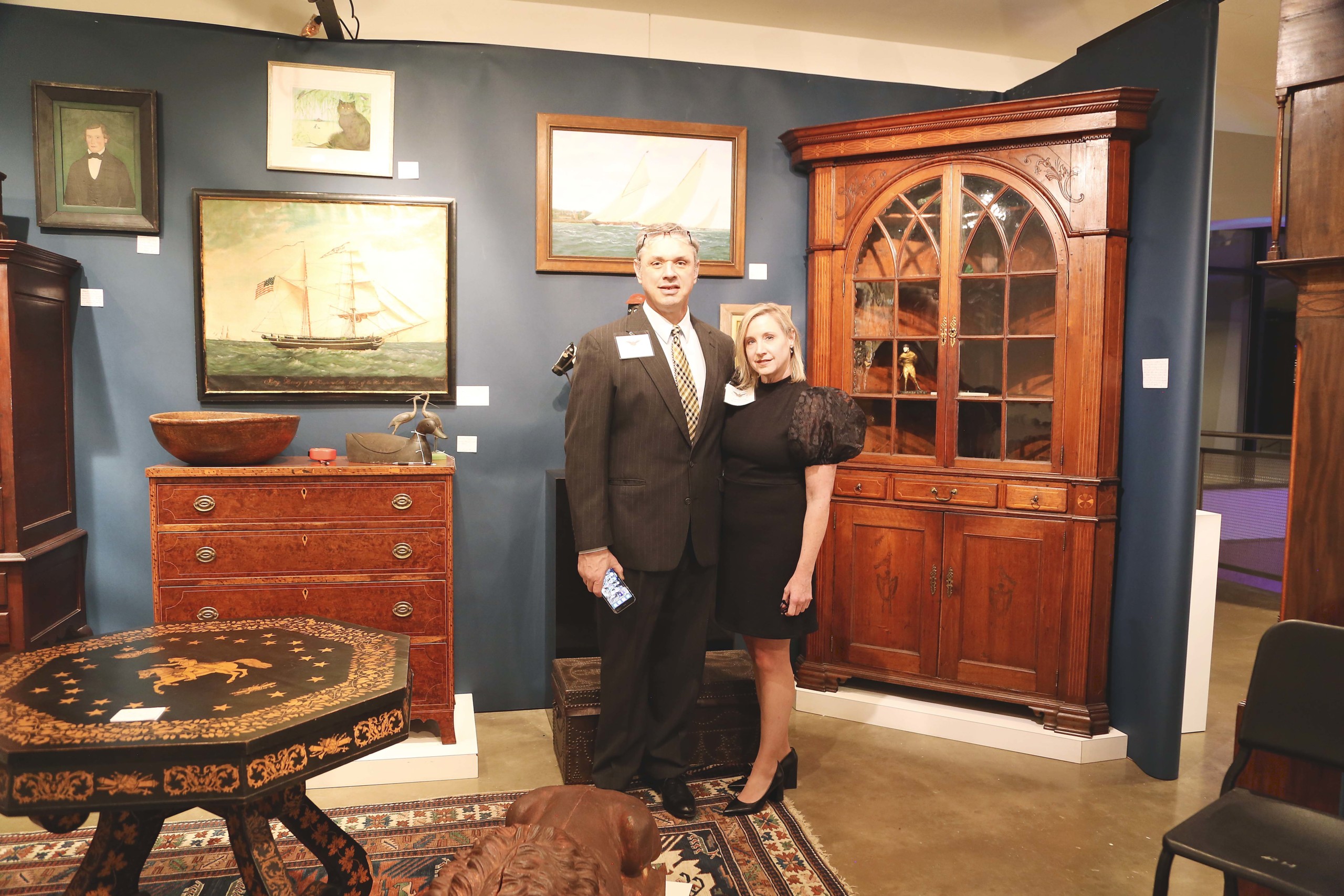
First-time exhibitor Blandon Cherry was joined by girlfriend Gretchen King. The two are flanked by a ship painting by James Guy Evans and a walnut corner cupboard, Maryland or Northern Virginia, which he had found in Frederick, Md. The chest of drawers next to them was one of the sales the Paris, Ky., dealer closed at the show.
Gary Sergeant holds court in the center of the second floor. His booth was well stocked with furniture, several pieces of which displayed publications they had been featured in, including a pair of English cockpen chairs, a set of four English side chairs that had been owned by Percy Macquoid, a Philadelphia piecrust table once handled by Joe Kindig and illustrated in the July 1941 issue of The Magazine Antiques and Thomas Butler’s “The Great Carriage Maker.”
“We look forward to this show every year, it’s always a consistent show and gets the year off to a good start,” noted Sergeant, who we caught up with as he was busy getting ready for the Wallace Hall Antiques Show in New York City. “We sold more accessories than furniture, though we did sell some. There was general interest across the board. Lesser-priced pieces were selling, more expensive things met with some resistance but that’s typical for that show. We had some inquiries about a pair of mirrors from a historic house in Washington. I’m very happy with how many new clients we made connections with, as well as how many new young collectors.
Silver Art by D&R were previously situated on the third floor but moved down to the second floor next to Sergeant. Though they always bring a beautiful selection of art and silver, several pieces stood out — “Nautical Pleasures” by Paul Emile Lecomte (French, 1877-1950); “The Purple Beach at Yonville” by Emmanuel de La Villeon; a pair of gilt bronze trays decorated with dolphins, made in Paris circa 1870; a Louis XVI style vermeil wine coasters by Risler and Carre; and a spectacular 180-piece flatware service by Henri Soufflot.
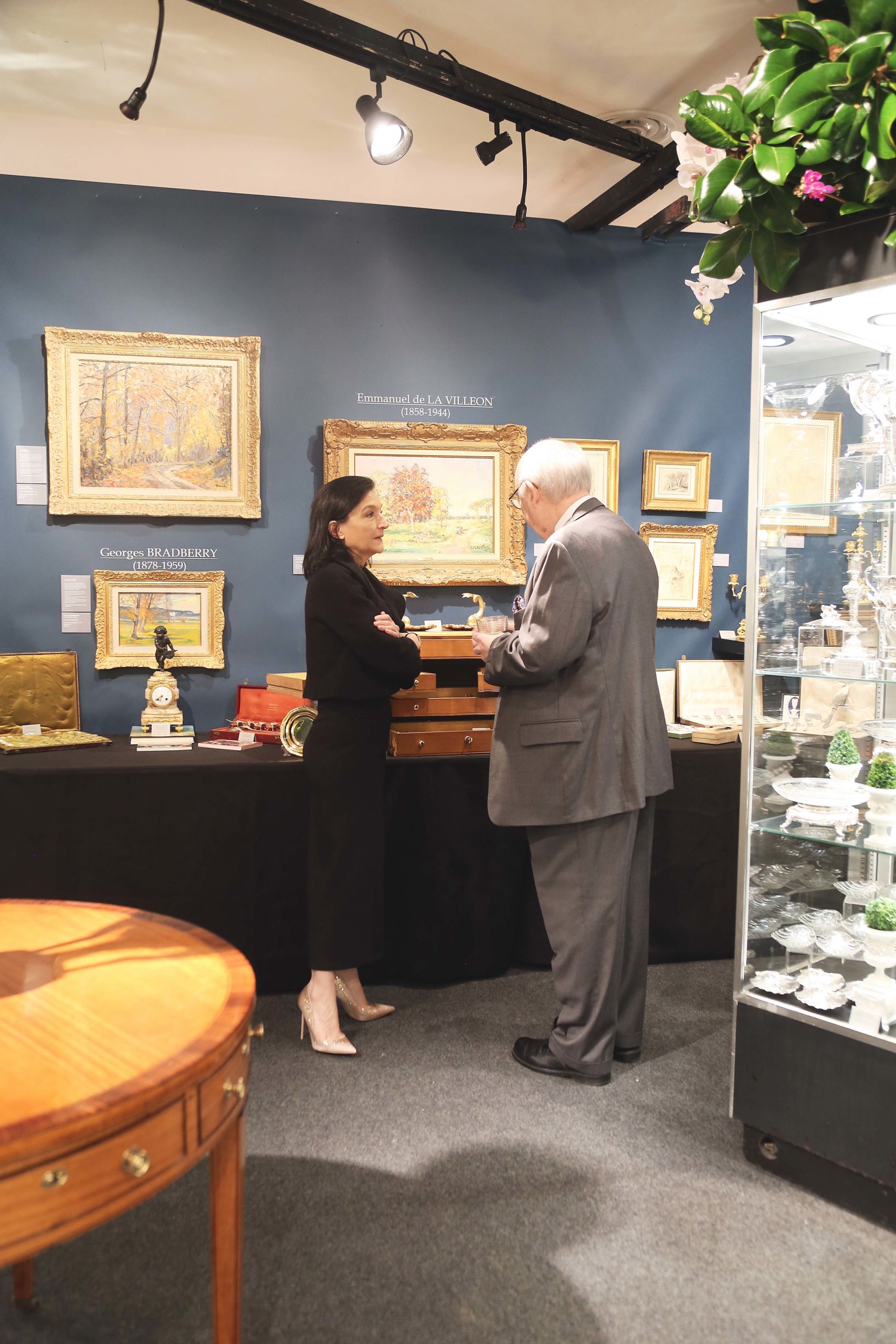
Jasmine Doussiere and a potential client standing in front of a 180-piece flatware service by Henri Soufflot. Silver Art by D&R, Baltimore, Md., & Marseilles, France.
With her previous across-the-aisle neighbor moving into another booth on the show floor, Ann Wilbanks was able to spread out a bit on the second floor. She brought a selection of half-hull models, including a 13-foot example of a US Navy Wickes Class destroyer that had been deaccessioned from a Camden, N.J., maritime museum. She said it was the longest half-hull model she’d ever handled.
“We had a really good show with sales spread over all four days, and Sunday was especially busy. Marine art is usually our strongest category, but this year, our sales were divided pretty equally between marine art, garden pieces, animal art and mirrors. Furniture was our only weak area. Customers seemed to be in a robust buying mood. Washington, for us, has been the show with the best post-show sales, so fingers crossed! We had a customer who had seen a pair of male and female stone heads salvaged from a Boston brownstone facade with us at the 2010 Baltimore Show; he had regretted not buying them ever since. They spent the intervening years beloved in our garden. He was ecstatic to finally purchase them 14 years later and said they were even prettier than he remembered! That was my favorite story from the show!”
Wilbanks’ neighbor is Carole Pinto who brought her usual vibrant selection of Nineteenth and Twentieth Century paintings and sculpture, reporting that she had a good show and was following up with clients who expressed interest in Post Impressionist and Impressionist paintings.
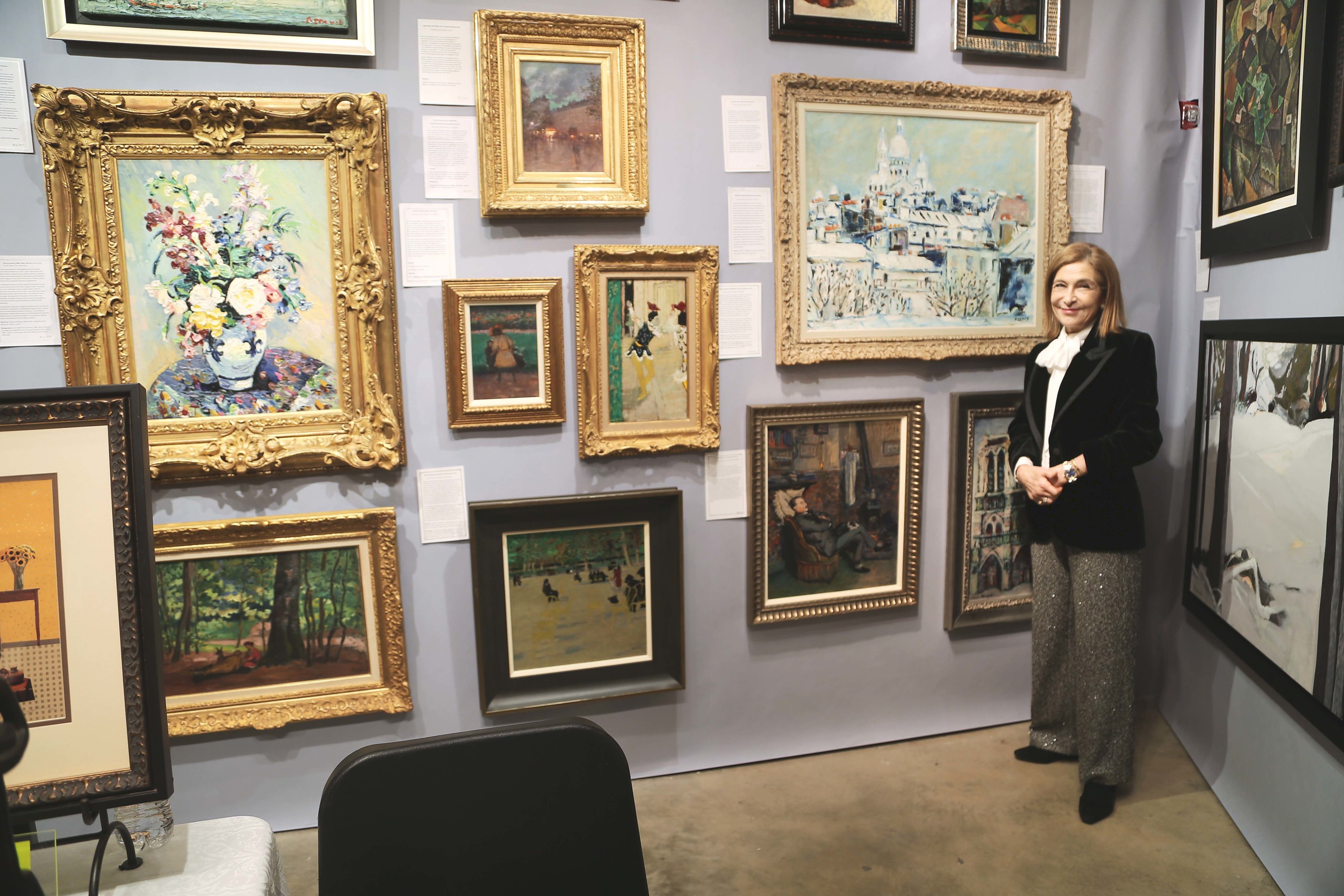
Carole Pinto standing next to “Sacre-Coeur in the Snow” by Robert Maurice Savary (French, 1920-1999). The vibrant still life on the left side of this photo is Pierre Dumont’s (French, 1884-1936) “Still Life,” which was included in an article Pinto recently authored in Art Houston titled “Hidden Gems.” Carole Pinto Fine Arts, New York City & Paris.
“I understand that many people will not buy a painting after seeing it the first time. I had a number of collectors come by Sunday and I gave them good prices, and managed to sell four paintings, enough to cover my costs and put some money in the bank. The works I sold were very colorful and animated, with great technique and in perfect condition. I was able to chat with the clients and explain to them wherein lies the value of each individual piece, so they could really appreciate the compositions they were looking at.”
Across the aisle from Pinto, Joy Hanes was returning to the show after a six or seven-year hiatus and said she was happy with how the show had been. “Portraits seemed to be the hot item. I sold both a big portrait of a mother and child, and a little pair of a blacksmith and his wife. My other hot category was ceramics, and I sold a number of good early pieces. Everyone liked the silhouettes, but I only sold one very good one to a collector. And, at the last minute, I sold a Connecticut Windsor chair to an 84-year-old man. I only mention his age because usually people in their 80s are talking about selling their things rather than bringing more things home!”
Tim Brennan and David Mouilleseaux, Period to Mod, had many fantastic things, including at the front of their booth, a pair of repousse tin and metal chairs in the British Raj manner that dated to the early Twentieth Century. The pair sold during the show, as did a period French canape signed by the maker, a Fern & Blackberry cast iron set, a set of 15 botanical watercolors, a bronze tree trunk base table and a Classical period mahogany box sofa, to name a few of their sales.
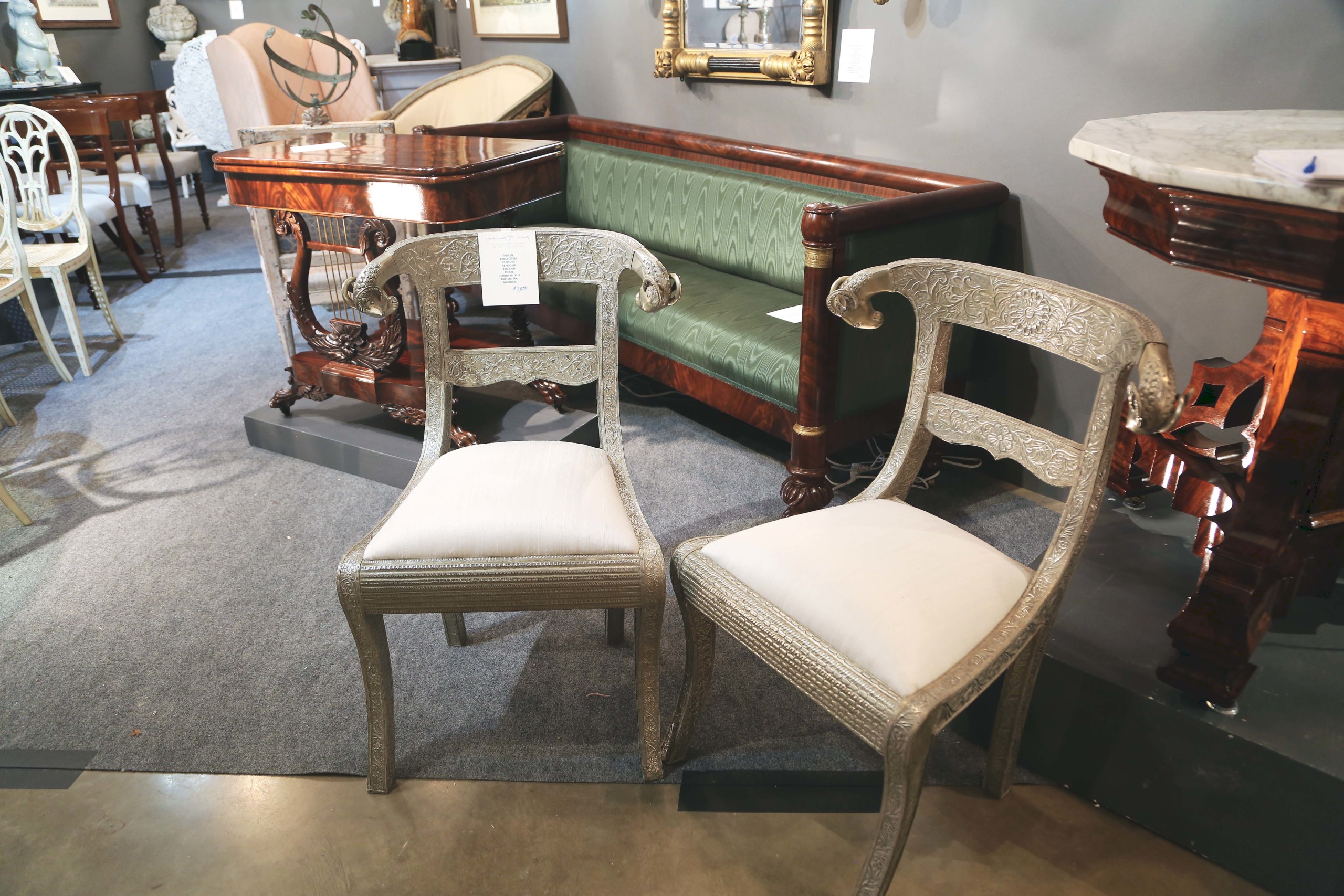
Scalamandré silk upholstery fabric elevated this pair of already fabulous early Twentieth Century repousse tin and metal chairs in the British Raj manner. The chairs sold, as did the American Classical box sofa behind them. Period to Mod, Brennan & Mouilleseaux Antiques and Design, Briarcliff Manor, N.Y.
After the show, Brennan told us, “It was our best Washington Winter Show ever. We can’t thank Karen DiSaia, Jonathan Willen and the committee enough for their help and support.”
On the third floor, Enrique Goytizolo of Georgian Manor Antiques brought several smalls in the forms of various animals, a perennial crowd-pleaser. The Fairhaven, Mass., dealer had a soapstone camel, an Italian glazed ceramic cat, a carved wood American owl, an English leather rhino, a model of the Medici lion in bronze, a Swiss Black Forest carved limewood nanny goat and, from China, a water buffalo carved out of ironwood.
Goytizolo’s neighbor, Sheryl Dunleavy, The Ann Parke Collection, also favors animals, but her niche focus is dogs of varied breeds. She presented art and objects in a broad range of price points and almost every medium possible.
Glen Leroux, who deemed it “a good show,” anchored one side of his booth with a charming vignette comprising a card table with playing card suite motifs — diamond, heart, club and spade in the four corners of the top — that he’d acquired from a Westport, Conn., estate. Leroux surrounded the table with four circa 1980s Italian ebonized armchairs and topped it with a Fantoni stoneware vase. All attracted interest but all were still available at press time.
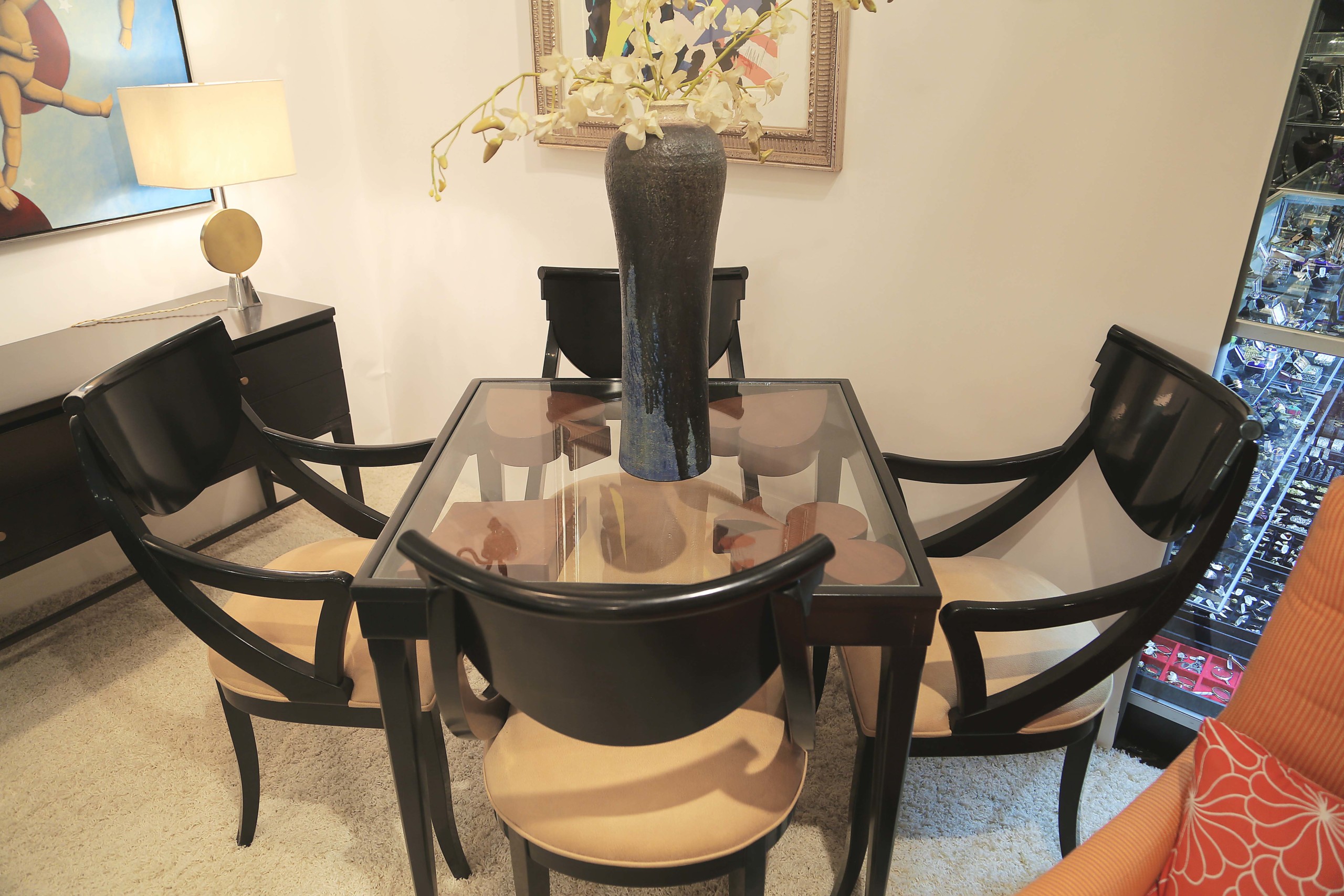
Glen Leroux, Westport, Conn.
Straight out of Austin, Texas, Lotus Gallery was returning for their second time. Jonathan Tung showed off a selection of Twentieth Century snuff bottles, which he said had “quite a bit of attention. The multitude of colors and designs were well received and garnered lots of interest. I had numerous conversations about them, explaining their use and how they were made. And a couple found new homes.” He also showed off a Sixteenth Century Tibetan figure of Vajrabhairava that had documented provenance. “That got a little less overall attention, but the attention it did get was more focused and informed, with a few major collectors and curators looking closely at it.” Summing up, Tung noted, “The show felt really fresh and exciting this year. Opening night was packed, and the show was well attended on all days, with the luncheon and lectures sold out. In addition to catering to its core audience, the organizers and committee really focused on introducing a new generation of collectors to the show, and it really showed. Sales for us were brisk, with a good mix of jewelry and objects.”
The 2025 Washington Winter Show will take place Friday-Sunday, January 10-12, with the Opening Night party on Thursday, January 9. For information, www.washingtonwintershow.org.















































